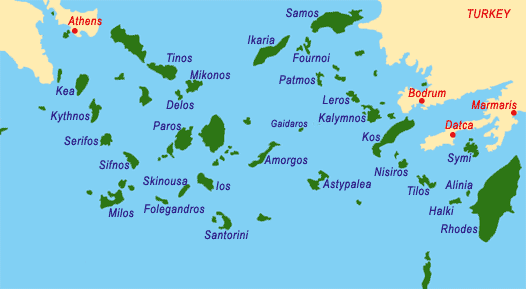 Kythnos
Kythnos
The island of Kythnos, or, as the locals call it, Thermia, lies between Kea (Tzia) and Serifos, 54 nautical miles from Pireaus.
Administratively, Kythnos belongs to the Kea province of the Prefecture of Cyclades. It has an area of about 100 sq. km. (38 sq. miles) and a circumference of 36 miles. The terrain is rocky with Ai-Lias (336 m.) the tallest pick.
Although Kythnos is not far from Piraeus and Kea, one can find there unexpected peacefulness. Here, too, the terrain is mainly mountainous, but the harshness of the bare earth is relieved here and there by vines or fig-trees like brushstrokes on it, while pretty little bays form indentations in its coastline. There are steep cliffs on the northern sid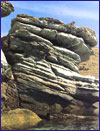 e of the island.
e of the island.
The small gulfs which keep the sea peaceful, the white houses, the streets and the old windmills, are some of the attractions of the island. Kythnos is close to Athens, so it is suitable even for weekends.
Beautiful beaches can be found at Meriha, Loutra (you can reach Loutra by bus from Meriha or Hora), Agios Stefanos (40' min. walk from Hora), Skylou, Kolona and Panagia Kanala. Other good beaches for swimming can be found at Episkopi and Flambouria bay (accessible only by boat).
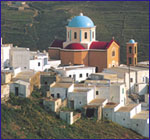 Serifos
Serifos
Between Kithnos and Sifnos, Serifos is 73 nautical miles from Piraeus. Bare, undulating hills interspersed with small, fertile valleys cover this picturesque island. The rocky coastline is deeply indented with a succession of coves and bays.
The curious rock formations resemble human figures which call to mind the myth of Danae, Perseus and Medusa, as if these prehistoric inhabitants of the island had been turned to stone.
The most interesting site of the island, the monastery of Taxiarhes is located on the main mountain, which looks like a castle. If you're looking for a quiet place, with wonderful beaches to spend your holidays, Serifos is the place.
According to mythology Perseas with his mother Danae, came to the island in a box that was thrown in the sea. Perseas grew up in the island and he was the one to kill the terrifying Medusa.
Ferries call at Livadi, the sheltered port on the eastern side of the island, where there is a long, horseshoe-shaped sandy beach.
Perched on the top of a steep hill, Hora or Serifos, the main town of the island, with its little cube-shaped houses and churches in the island style, with its Venetian castle above, looks like a fairy tale town.
The fortress-like monastery of the Archangels (moni Taxiarhon), near the village of Galani, which houses some fine wall-paintings and important books and manuscripts, is of special interest.
The village of Panagia (which takes its name - meaning 'Our Lady' - from the dedication of a fine 10th century church) commands a panoramic view of the whole island.
The greatest attraction of Serifos is its magnificent beaches (Mega Livadi, Koutalas,Agios Sostis, Psili Amos, Agios Ioannis, Sikamia).
 Sifnos
Sifnos
Sifnos is one of the six islands that make up the Western Cyclades. It is wellknown both in Greece and abroad, for its unique and changeless traditional whitened buildings harmonising enchangly with the natural surroundings, for its remarkable cleanliness, for its countless churches and monasteries and its superb beaches.
The history of Sifnos began abot 3200B.C. and through the years it has been influenced by great civilizations, like the Minoan and the Mycenean civilization.
Apollonia, the capital of the island, spreads amphitheatrically over three hills.
1,5 kilometres north of Apollonia is picturesque Artemonas, with its windmills crowning the hill and a panoramic view.
 Kamares, the port of the island has a beautiful setting, humming with life in summer. It has a large beach and numerous ceramic workshops.
Kamares, the port of the island has a beautiful setting, humming with life in summer. It has a large beach and numerous ceramic workshops.
Platis Gialos is the most popular beach of the island and is the largest one in the Cyclades.The small villages of Vithi, Faros and Hersonisos with their little bays, are also worth seeing.
There are hotels, pensions, apartments, private rooms and camping sites almost all over the island. Nightlife on the island is also very good. Tavernas and restaurants with Greek and local specialities, bars and discos.
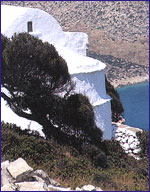 Ios
Ios
Ios is a small island but with much to offer. Tradition claims that this is the island where the tomb of the poet Homer lies. Important characteristics of Ios are the Byzantine Castle in Paleokastro which overlooks the Aegean Sea and 16th century church of St.Theodoti which is the most ancient one left on the island. Also many other churches like the Byzantine church of Agios Ioannis, that is built on the ruins of the temple dedicated to Apollo and the monastery of Kalamos.
Beautiful beaches are not unusual on this island. Theamazing beach of Plakotoand of cource Psathi, an extensive beach with beep blue water and white sand, one of the finest breeding places for the sea-turtle. Also the pebbly beach of Kalamos and the beaches of Managari, fou of the most beautiful beaches in the Aegen Sea, wait for the visitor to enjoy their peaceful nature.

Santorini
 Santorini, one of the best-known of the Cyclades, differs from the other islands in the group thanks to its geological morphology, the result of action by a volcano now dormant. The landscape on the western side of the island, where towering cliffs crowned by tiny and blindingly- white houses plunge straight into the depths of the sea. The steep coastline of the west is countered by the vast beaches of the east side, some of them sandy and others with pebbles.
Santorini, one of the best-known of the Cyclades, differs from the other islands in the group thanks to its geological morphology, the result of action by a volcano now dormant. The landscape on the western side of the island, where towering cliffs crowned by tiny and blindingly- white houses plunge straight into the depths of the sea. The steep coastline of the west is countered by the vast beaches of the east side, some of them sandy and others with pebbles.
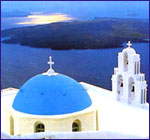 From the landing-place, Skala, we can climb up to Fira, the capital, on foot or on donkey-back. There is a funicular railway for those who wish to avoid the hundreds of steps. Fira is very attractive, with winding narrow streets, arcades and a quarter where the Catholic nobility once dwelt. There is a most important Museum, with prehistoric finds (mostly pottery), a large collection of vases dating from the 7th and 6th centuries BC (including the pieces known as 'Thera ware'), a few Archaic and Classical pieces, and some Hellenistic and Roman sculptures and portraits. There is a superb view out from Fira to the Kamenes, the two islets of black stone created by the volcano. The islets can be visited by launch. Ancient Thira is a site of great archaeological interest which was occupied by Phoenicians, Dorians, Romans and Byzantines. Down the centre of the city runs the Sacred Way. The buildings include groups of houses, market-places, baths, theatres, sanctuaries, the residence of Ptolemy Euergetes, tombs of the Archaic and Cl
From the landing-place, Skala, we can climb up to Fira, the capital, on foot or on donkey-back. There is a funicular railway for those who wish to avoid the hundreds of steps. Fira is very attractive, with winding narrow streets, arcades and a quarter where the Catholic nobility once dwelt. There is a most important Museum, with prehistoric finds (mostly pottery), a large collection of vases dating from the 7th and 6th centuries BC (including the pieces known as 'Thera ware'), a few Archaic and Classical pieces, and some Hellenistic and Roman sculptures and portraits. There is a superb view out from Fira to the Kamenes, the two islets of black stone created by the volcano. The islets can be visited by launch. Ancient Thira is a site of great archaeological interest which was occupied by Phoenicians, Dorians, Romans and Byzantines. Down the centre of the city runs the Sacred Way. The buildings include groups of houses, market-places, baths, theatres, sanctuaries, the residence of Ptolemy Euergetes, tombs of the Archaic and Cl assical periods and Early Christian remains. On the surrounding rocks the names of the god Apollo and of men and boys are inscribed in the ancient alphabet of Thira. The site at Akrotiri has yielded the remains of a Minoan city destroyed around 1500 BC by an eruption of the volcano on Thira. In effect, this is a prehistoric version of Pompeii buried beneath volcanic ash, with two and three-storeyed houses, with squares, shops, workshops and so on. Among the finds from the houses were marvelous murals (on display in the National Archaeological Museum, Athens), vases, and everyday utensils.
assical periods and Early Christian remains. On the surrounding rocks the names of the god Apollo and of men and boys are inscribed in the ancient alphabet of Thira. The site at Akrotiri has yielded the remains of a Minoan city destroyed around 1500 BC by an eruption of the volcano on Thira. In effect, this is a prehistoric version of Pompeii buried beneath volcanic ash, with two and three-storeyed houses, with squares, shops, workshops and so on. Among the finds from the houses were marvelous murals (on display in the National Archaeological Museum, Athens), vases, and everyday utensils.
 On the highest peak of Santorini is a monastery of the Prophet Elijah (Profitis Ilias), where there is a picturesque religious feast on 20 July each year. The old-world village of Ia, 11 km. to the north of Fira, is a place of incomparable beauty. The unique appeal of Ia lies in its little houses hewn out of the soft rock (some of them whitewashed, others painted blue or ochre), its neo-classical mansions with their courtyards, its narrow paved alleys. There is a superb view out to sea. Among the best bathing beaches - some of them with black sand and others with pebbles - are Kamari or Armeni, Amoudi, Baxedes Perissa, Monolithos and Kokini Paralia. The striking landscape, the peculiarities of the natural environment, the unusual architecture and the outstanding monuments of Santorini attract very large numbers of visitors in the summer - so many, in fact, that the excellent tourist amenities of the island can only just cope with them.
On the highest peak of Santorini is a monastery of the Prophet Elijah (Profitis Ilias), where there is a picturesque religious feast on 20 July each year. The old-world village of Ia, 11 km. to the north of Fira, is a place of incomparable beauty. The unique appeal of Ia lies in its little houses hewn out of the soft rock (some of them whitewashed, others painted blue or ochre), its neo-classical mansions with their courtyards, its narrow paved alleys. There is a superb view out to sea. Among the best bathing beaches - some of them with black sand and others with pebbles - are Kamari or Armeni, Amoudi, Baxedes Perissa, Monolithos and Kokini Paralia. The striking landscape, the peculiarities of the natural environment, the unusual architecture and the outstanding monuments of Santorini attract very large numbers of visitors in the summer - so many, in fact, that the excellent tourist amenities of the island can only just cope with them.
 Thirassia, off Santorini near Ia, is the largest of a chain of islets formed by volcanic activity and the only one inhabited. Its sole village, Horio, is a pretty place with whitewashed houses, reached by a flight of 250 steps from the landing-place. In the winter, there are caiques from Ia to Thirassia, while in the summer months the travel agencies of Santorini run trips from Fira and Athinios.
Thirassia, off Santorini near Ia, is the largest of a chain of islets formed by volcanic activity and the only one inhabited. Its sole village, Horio, is a pretty place with whitewashed houses, reached by a flight of 250 steps from the landing-place. In the winter, there are caiques from Ia to Thirassia, while in the summer months the travel agencies of Santorini run trips from Fira and Athinios.
 Folegandros
Folegandros
Folegandros is one of the most alluring Greek islands. Since the early 1980s tourists have been coming in increasing numbers to Folegandros. Despite this, as many of the inhabitants earn a living from fishing and agriculture as they do from tourism.
Those who visit Folegandros, are those who want a taste of genuine island life rather than a nonstop party, and the locals having seen what happened to Ios, are determined to keep it this way. Admitelttedly, Folegandros gets crowded during July and August, but come any other time and it's a blissful place. The island has several good beaches and a striking landscape of cutlivated terraces giving way to precipitous cliffs.
The Hora or Folegandros, which is consists of two settlements, is situated above the harbour at Karavostassis. In the old part of the town, in the area of the kastro, the outside walls of the houses form a fortifying wall (as is the case on many cycladic islands).
The more recent settlement is equally attractive, with its narrow little alleyways, low stone walls, courtyards, wooden balconies and Aegean-style churches. The finest church on the island, that of the Panagia, was built on part of the wall of the ancient town.
Slightly further lies Chryssospilia, which has some magnificent stalactites, stalagmites and relics from antiquity, and the area of Ano Meria, comprising a number of small hamlets, where the colourful feast of Agios Panteleimon is celebrated on 27th July. There is an Ecology and Folk Museum in Ano Meria which contains exhibits and scenes reconstructed from the traditinal peasant way of life on the island.
Excellent beaches for swimming are to be found at Karavostassis, Livadi and Agios Georgios Bay in Ano Meria.
There is a pebble beach at Karavostassi, and also at Livadi Beach, the next bay around. The island's finest beach is sandy Angali, where there are several rooms and taverns. Other good beaches are Agios Nikolaos and Livadaki, both north-west of Angali, and Agios Georgios, which is north-west of Ano Meria. A path from Ano Meria's Church of Agios Andreas leads to Agios Georgios beach.
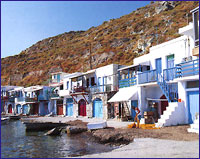 Milos
Milos
Milos is the most southerly island in the Western Cyclades. It is notable for its volcanic soil and for the rich deposits of minerals that lie beneath. It has a distinctive horseshoe shape.Milos is best known all over the world for the famous statue of Aphrodite which was found here.
There are various kinds of beaches in Milos. Some of them are wonderful beaches with golden sand and some of them have sharp rocks and caves that look like they have been taken out from some tale. Any traveller going to Milos will surely be pleased from the sites of the island and the touristic infrastructure.
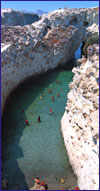 Adamas, one of the safest natural harbours in the Aegean, is a particularly charming spot, with whitewashed houses, cobbled alleys, balconies crammed with flowerpots and fragrant tamarisks which have been extolled by the poets.Milos or Plaka, capital of the island today stands on a hillside overlooking the sea at the foot of the castle. It is a most attractive town, with architecture in the characteristic Cycladic style.Among the most notable of its churches are those of Our Lady "Korfiotissa", Our Lady "Thalassistra" and Our Lady "Messa Panagia".At the north-eastern extremity of Milos is the modern resort of Polonia or Apolonia.Close by (3 km.) is Phylakope, the most important centre of population in Minoan times; the ancient city was built in three phases. Next to the archaeological site is the spectacular Papfranga cave. The sea-cave called Kleftiko is at the south end of the island. However, the most important monument on Miles is the island's famous catacombs, now open to the public. They are located at the village of Tripiti, 2 km. from the main town of Plaka and they are among the most important of Early Christian monuments. The nearby islets of Antimilos, Arkadies and Glaronissia are also of interest, each in its own way.
Adamas, one of the safest natural harbours in the Aegean, is a particularly charming spot, with whitewashed houses, cobbled alleys, balconies crammed with flowerpots and fragrant tamarisks which have been extolled by the poets.Milos or Plaka, capital of the island today stands on a hillside overlooking the sea at the foot of the castle. It is a most attractive town, with architecture in the characteristic Cycladic style.Among the most notable of its churches are those of Our Lady "Korfiotissa", Our Lady "Thalassistra" and Our Lady "Messa Panagia".At the north-eastern extremity of Milos is the modern resort of Polonia or Apolonia.Close by (3 km.) is Phylakope, the most important centre of population in Minoan times; the ancient city was built in three phases. Next to the archaeological site is the spectacular Papfranga cave. The sea-cave called Kleftiko is at the south end of the island. However, the most important monument on Miles is the island's famous catacombs, now open to the public. They are located at the village of Tripiti, 2 km. from the main town of Plaka and they are among the most important of Early Christian monuments. The nearby islets of Antimilos, Arkadies and Glaronissia are also of interest, each in its own way.
Miles has excellent beaches at Hivadolimni, Polonia, Adamas, Emborio, Provatas, Paleohori Agia Kiriaki, Lagada, Papikinou, Aliki, Fatourena, Ribari and Agio Dimitrio.
Hydra
Hydra is an island with many admirers, among the international community of writers, actors and artists in general. Perhaps because of its unique charm, or perhaps because of its rare combination of simplicity and sophistication. You can walk, under the shade of grapevines, on its narrow cobblestone streets, that lace around the old houses, following their wild climb, almost to the top of the steep hills. Or you can just rest, lying on a rock by the sea. No matter what, Hydra will charm you just the same. Hydra, with its historically - preserved architecture, its numerous churches, and its donkey transportation, is one of the most picturesque islands.
Hydra Main Harbor – If you want to tie in the main harbor I suggest you get in early, especially on the weekends as it is a favorite for the Greeks. Care must be taken when they are N-NW winds and you should opt for the N mole. Due to the harbor is overcrowded in the summer it is usually for yachts to be three out from the quay. Crossed anchors are a common event so don't be surprised. Water is available on the quay, as well as provisioning.
Mandraki – This bay is located ?? of mile E of Hydra. It is a nice bay for a swim There are taverns ashore. The bay is fairly sheltered except to northerly winds.
Petassi - There are several small coves in the area that can be used.
Ag. Nikolaos – This is a beautiful bay with nice surroundings and crystal clear water for a swim but can only be used in calm weather.
Nisis Dhokos – A barren island SW end of Hydra. The winds in the channel vary and usually die down. A safe anchorage which is well protected.
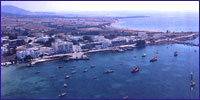 Paros
Paros
Paros, the third largest of Cyclades after Naxos and Andros has developed into an important center of tourism in recent years. Gently rolling hills surround the center and south-east of the island which is predominately agricultural and is occupied by endless vineyards, and lock within themselves the famous Parian marble. The coastline is indented, with numerous small inlets and two large bays, those of Naoussa in the north and Parikia in the west. Paros has been inhabited since very ancient times, and was one of the centers of the Cycladic civilization.
Parikia (or Paros), the island capital and port, stands on the site of an ancient city. There is a picturesque and ruinous Venetian castle and the courtyards of the houses of the town -all of them painted white- are full of pots of basil and hung with jasmine and honeysuckle. A broad paved avenue leads to the church of Ekantondapiliani or Katapoliani, one of the most important Byzantine monuments in the whole of Greece and a place that figures largely in legend. It is dedicated to the Dormition of our Lady, and on her feast day (15 August) there is a great celebration on the sea-front with fireworks and songs of the sea
Other interesting local events take place on the island during the summer. Statues found at various sites on Paros are on display in the National Archaeological Museum, Athens.
Naoussa, one of the prettiest villages in Cyclades, with white washed houses, narrow paved alleys, arches and tiny chapels can also offer a range of excellent beaches and attracts many visitors each summer.
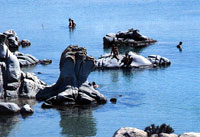 Among the beaches near Naoussa, special mention should be made of Kolibithres, where huge rocks eroded into strange shapes remind the visitors of sculptures embedded in the sand.
Among the beaches near Naoussa, special mention should be made of Kolibithres, where huge rocks eroded into strange shapes remind the visitors of sculptures embedded in the sand.
The chapels and monasteries of Paros are famed for their picturesqueness; among the most characteristic are the monastery of Zoodohos Pigi 'Longovarda' and that of Christ of the Forest (Hristos tou Dassous).
Marpissa is an attractive large village with a Venetian castle and beautiful churches. Among the best swimming beaches are Livadia, Krios, Agios Fokas, (at Parikia), Mikro Piperi and Megalo Piperi, Limnes, Kolimbithres (at Naoussa), Agii Anargiri, Langeri, Aliki, (with an interesting exhibition of traditional crafts), Santa Maria, Ambelas, Pisso Livadi, and Drios (on the eastern side).
Paros is an ideal destination for those in search of cosmopolitan bustle and for lovers of solitude alike. It has a full range of tourist amenities.
Aegina
The closet island as you depart from Kalamaki marina and is usually the first or last stop of your trip if you are sailing the Saronic Gulf. The Temple o Aphia is well worth a visit. You can either visit by taking the bus from the main harbor or moor in Agia Marina and take the caique. The temple is one of the best developed classical temple in Greece. Don’t forget to stock up on pistachios as they are produced on the island of Aegina and are probably the best in Greece.
· Main Harbor Aegina – A well sheltered harbor but when there are strong southerly winds it does have a bit of a swell. Mooring is stern-to or bow to the quay. A good place for provisioning, water and fuel.
· Perdika – Small bay on the SW of Aegina. It is a good shelter from normal winds the bay is open to the west but Nisis Moni does offer protection from westerly winds. Care must be taken if you decide to tie quay. Depths vary from 1,5M to 1,9M so some care must be taken. No fuel available, water can be arranged. The taverns on Perdika have excellent fresh fish.
· Ag. Marina – A large open bay located in the NE corner of the island. Mooring is in the bay . This area is not well sheltered but if the weather is calm it is a nice area to moor in
 Kea
Kea
The island of Kea belongs to the Cyclades. Its many quiet beaches and the rich historical tradition make it the perfect destination for long and short vacatios.
Korrisia, the port of the island, is built on the ruins of the ancient town Korissos and along with Ioulida, Karthaia and Piiesa, they are the four towns of the island.
This is the island, where the famous statue the 'Kouros of Kea' was found and is now in the Archeological Museum in Athens.
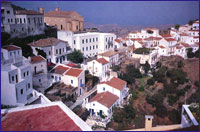 The capital of Kea, Ioulida, was built on the mounten, in order to be protected from pirates.
The capital of Kea, Ioulida, was built on the mounten, in order to be protected from pirates.
The settlement is one of the most well-preserved in the Cyclades and its' arcitectural personality, with the stone-paved paths, the neoclassic buildings, the churches and the red roofs make a wonderful scenery.
In the Archeological Museum one can see interesting exhibits of the Cycladic art and the Castle reveals one of the most amazing sunsets.
 Tinos
Tinos
Tinos lies very close to the southern tip of Andros. This is the holy island of Our Lady, which in August is swamped by pilgrims who have come to pray in Her church or in fulfillment of a vow. As Our Lady's feast day on 15 August approaches, the church and the town of Tinos become crammed with people, and religious services take place next to the commercial fair being held in the surrounding streets.
A line of mountains, whose highest peak is Mt. Tsiknias (in the myths, the home of the wind-god Aeolus), runs the length of the island. On its lower slopes, walls like the fortifications of old castles divide the terraced fields. The coast of the island is mostly steep, but there are also numerous coves with sandy or pebbly beaches. Among the special characteristics of Tinos are its dovecotes. These structures developed from simple roosts for pigeons into works of art - and the stone-built fountains to be seen in the villages evolved in a similar manner.
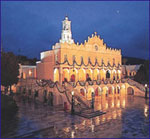 At Xombourgo, we can admire the ruins of the medieval castle, on the south side of which is a sanctuary of Demeter and Persephone. The interior of the island has been little affected by tourism, and the 45 villages have retained much of their traditional character and distinctive vernacular architecture. Among the most interesting villages are the large settlements of Falatado, Steni and Pirgos, the latter of which has a museum dedicated to the sculptor Halepas, the house of the artist Lytras and numerous marble-sculptors' workshops. Among the monasteries of the island, many of them built on superb sites, we could single out that of Our Lady of the Angels at Kehrovouni (Panagia ton Angelon) which has the appearance of a Tinos village in medieval times.
At Xombourgo, we can admire the ruins of the medieval castle, on the south side of which is a sanctuary of Demeter and Persephone. The interior of the island has been little affected by tourism, and the 45 villages have retained much of their traditional character and distinctive vernacular architecture. Among the most interesting villages are the large settlements of Falatado, Steni and Pirgos, the latter of which has a museum dedicated to the sculptor Halepas, the house of the artist Lytras and numerous marble-sculptors' workshops. Among the monasteries of the island, many of them built on superb sites, we could single out that of Our Lady of the Angels at Kehrovouni (Panagia ton Angelon) which has the appearance of a Tinos village in medieval times.
There are plenty of good beaches, too, notably at Agios Fokas near the town, Kionia, Porto, Panormos bay, Kolimbithra, Agios Sostis and Pahia Amos. The lunar landscape at the spot known as 'Volax', with its peculiar boulders, is probably unique anywhere in the world. The beauties of Tinos are gradually making a name for themselves. Although amenities for tourists outside the town are scanty, they are constantly expanding.
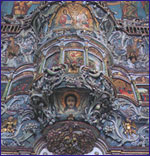

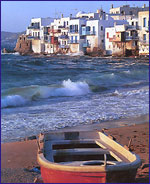 Mikonos
Mikonos
Mykonos is world famous. It is no coincidence that this, the most cosmopolitan of all Greek islands, attracts so many visitors from all over the globe, including large numbers of artists and intellectuals. Here, the steep mountains to be encountered in most of the Cyclades give way to low, rocky hills which combine with superb beaches to make up the landscape of the island.
The capital, Hora, with its colorful harbor in which little fishing-boats nestle happily side by side with luxury yachts, presents quite a different picture from the majority of Aegean island towns. While it is usual for island villages to be built on naturally amphitheatrical sites, Mykonos is spread out over a flat area and conveys an impression of solid aesthetic cohesion.
Mykonos is a busy island with all the amenities of a modern resort and with plenty to do - by day or night - for those who want to have a lively time. Yet visitors fond of more peaceful holidays will still find quiet corners in which to relax.
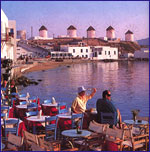
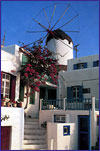
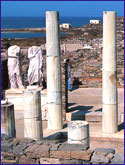 Delos
Delos
Despite its diminutive size, Dilos is one of the most important archaeological sites in Greece, and certainly the most important in the Cyclades. Dilos was a place of such importance that the surrounding islands were known as the Cyclades, since it was thought that they lay in a circle round the island on which the god Apollo was born.
According to mythology, Leto, pursued by Hera, found refuge on a floating rocky island, which  Poseidon then anchored to the sea bottom with pillars of granite. Here, under the palm, she bore to Zeus the twins Apollo and Artemis, attended by Arge and Opis, two maidens from the hyperborean regions of the north, which the god was required to visit annually.
Poseidon then anchored to the sea bottom with pillars of granite. Here, under the palm, she bore to Zeus the twins Apollo and Artemis, attended by Arge and Opis, two maidens from the hyperborean regions of the north, which the god was required to visit annually.
Towards the end of the 3rd millennium BC this earlier population established a settlement on the hill of Kinthos, followed in the 2nd millennium by another settlement in the area of the later Sacred Precinct.
 Skinousa
Skinousa
Sikinos has retained all of its island character, and this adds to its attractions for those in search of peace and an authentic atmosphere. The island has been inhabited since ancient times, as has been proved by the finds made in the Episkopi district.
The only road on Sikinos links Alopronia, the island's harbour, with Hora or Kastro, one of the most beautiful villages anywhere in the Cyclades. There are fine stone mansions to admire, and a church of Our Lady 'Pantanassa'. The Zoodohos Pigi monastery, built on the peak of a rock, is more reminiscent of an impregnable castle from a distance. As on all the more isolated Cycladic islands, the local religious feasts are celebrated with great enthusiasm.
There are a few rooms for rent on Sikinos, all of them in Hora. Basic meals are served at the island's restaurants and tavernas.
 Amorgos
Amorgos
The oblong shape of the mountainous and barren island of Amorgos lies on the eastern edge of the Cyclades, almost in the Dodecanese. In some places, the coastline is steep and rocky, while elsewhere it forms quiet, shady bays. The ruins to be found all over the island and the important archaeological finds discovered there (some of which are in the National Archaeological Museum, Athens) are testimony to the fact that Amorgos was inhabited in prehistoric times and was a place of great importance during the period of the Cycladic civilization. In antiquity, there were three flourishing and independent cities on Amorgos: Minoa, Arkessini and Egiali.
Katapola
At Katapola, the main harbour of the island today and the location of the interesting church of Our Lady 'Katapoliani' (built on the site of a temple of Apollo), traces of ancient Minoa have come to light. Swimmers will be delighted by the superb beaches to be found in the vicinity.The whitewashed houses of the capital of the island, Hora or Amorgos, spread out beneath the Venetian castle which stands on the peak of the hill. The typical Cycladic architectural style of the double or 'twin' church is much in evidence here. The Archaeological Museum has finds from all over the island and is well worth a visit.
To the north-east of Hora, at the foot of a rock, is the Byzantine monastery of Our Lady 'Hozoviotissa', one of the most important monuments of its kind. The second port of Amorgos, Egiali, is a pretty village famed for its superb sandy beaches and consisting of three distinct 'quarters'. It is easier to reach Egiali by sea than 32 along the poor and steep road linking it to Hora. In the south of the island, Arkessini stands near the site of the ancient city of the same name, amid a group of picturesque whitewashed hamlets. The road network of Amorgos is nearing completion, and will link up all the villages on the island. Amorgos has few hotels or rooms to rent. Yet despite the limited facilities available for visitors, the fine beaches and particular beauty of the island attract more and more tourists each year.
